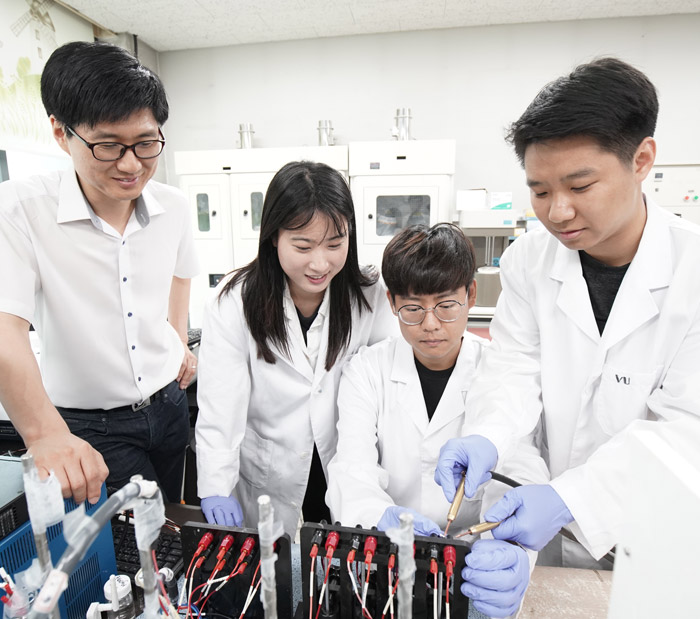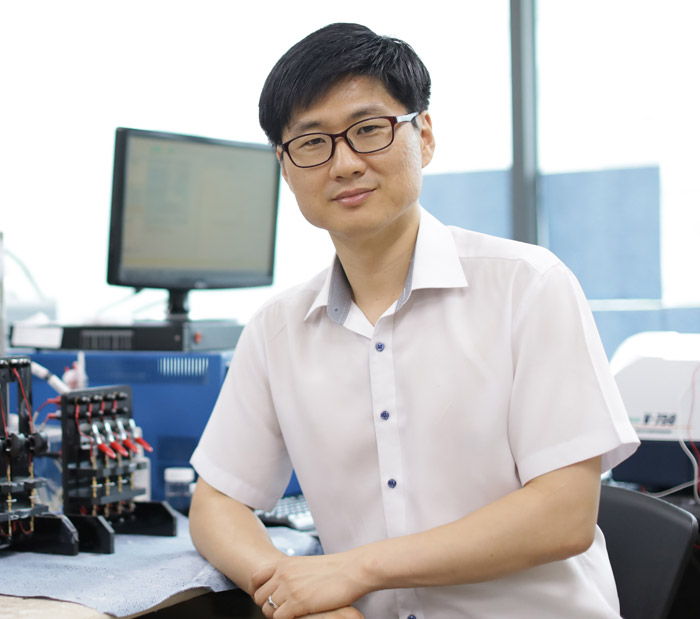Research Stories
First in the world to develop energy storing mechanism of two-dimensional graphene/phosphorene
Has 4 times larger capacity and maintains 91% of full charge rate after 50,000 times of charging in comparison to the previous activated carbon
Chemical Engineering
Prof.
PARK, HOSEOK
Development of Radially Assembled Graphene Microspheres with Sulfur-Nanorods for Lithium-Sulfur Batteries
Researchers from Sungkyunkwan University have developed the sulfur nanorods immobilized on radially assembled open-porous graphene microspheres cathode material for Lithium-Sulfur Batteries (LSB). This research was published online on March 12 on ACS Nano.
LSB, which have received much attention as a next-generation battery, had some problem to overcome before commercialization, such as low conductivity of sulfur, volume expansion, and shuttle effect. The research team first demonstrated rod-like nanosulfur strongly interacting with hierarchical radiaaly assembled open-porous spherical rGO, which are synthesized through controllable spray-frozen (SF) assembly. In the synthesized composite (rGO/nS), uniformly rod-like sulfur nanoparticles are distrubuted in the areas that formed a strong bond between surface of graphene and sulfur, greatly improving stability of LSB. In addition, the radially open-pore type spherical structure made electrolyte penetration easier, enhancing utilization of sulfur. The synergistic effect of the two have shown excellent stability, and high performance in LSB.
As a result, The rGO/nS hybrid provides a specific capacity and first-cycle Coulombic efficiency of 1269.1 mAh/g and 98.5%, respectively. A 4C capacity of 510.3 mAh/g and capacity decay of 0.08% per cycle over 500 cycles.
“This synthesis method is a new technology that allows granulation in the ball shape of micro-sized regardless of the type of nanomaterials, while simultaneously controlling the open-porous structure and ball shape.” explained Prof. Ho Seok Park, the corresponding author. Moreover, “it will help to offer a solution that can push ahead with the commercialization of LSB in the future.”, he added.
(a) Schematic illustrations about the synthetic procedures of radially oriented open-porous spherical R-rGO/nS and (b) Long-term cycle stability data at 0.1C and Coulombic efficiencies of R-rGO/nS.
MXene/Polymer Hybrid Materials for Flexible AC Filtering Electrochemical Capacitors
SKKU researchers have successfully realized high volumetric capacitance along with the high-frequency response, and turned the electrochemical capacitor (EC) technology successfully towards the development of form-factor-free miniature and scalable systems for Alternating current (AC) filtering application and energy storage system for pulse energy harvesters. This research was published online on November 8th 2018 in Joule Cell-Press(2019,3,164-176).
Aluminum electrolytic capacitors (AECs) have been used as power devices for AC filtering applications, and are critical for the IoT (internet of things) and self-powered wearable sensors. The capacitance of AECs is much lower than that of ECs, called supercapacitor or ultracapacitor. The rigid shape and bulkiness of AECs are obstacles for their use in miniature and flexible systems. Therefore, the development of flexible ECs that provide high volumetric capacitance and operate in the frequency range of AECs would have an enormous impact. This work carried out systematic approaches to tackle different issues of ECs to replace AECs and open up the opportunities for its further development.
Particularly to tackle the issue, the porous MXene/conducting polymer hybrid thin films have been produced, which has an interconnected network structure at the optimum composition and thickness. This maximized the charge transport properties and storage capability of the MXene hybrid thin films, areal and volumetric capacitances of 0.56 mF cm-2and24.2Fcm-3 at 120Hz and enabling operation even at a rate of 1,000Vs-1 or from 60 to 10,000Hz, with extreme flexibility and durability. Additionally, Prof. Ho Seok Park claimed that, “the used coating method is scalable and prepared hybrid electrodes are mechanical robust, so readily available recipe to support self-powered wearable electronics through commercialization”.
(A) This Figure was selected as the cover image in Joule, (2019), Volume 3, Issue 1, p1-p304. (B) Schematic representation of synthesis approach and digital photographs showing scalability and mechanical features of prepared electrodes. (C) Areal capacitance and (D) AC filtering capability of prepared ECs at different frequencies. (E) Long-term cycle stability of ECs in different mechanical states.
Extrinsic Pseudocapacitance of Molecular-Level Controllably Oxidized Black Phosphorus Nanosheets
Researchers from Sungkyunkwan University have discovered the new functionalities on the surface of black phosphorus (BP) nanosheets through chemically controlled functionalization at the molecular-level, revealing the new charge storage mechanism, that improves the overall electrochemical performance. The story of this work was published online on December 10 on Nature Materials.
Supercapacitor is one of the promising energy storage devices due to its high power density. However, there are clear limitations such as low energy density and poor rate capabilities. Thus, the new storage mechanism of extrinsic pseudocapacitors, storing charges through redox reaction at surface or near surface, is considered to become a candidate of next-generation energy storage devices. This research team has found that P=O sites has an ability for surface redox charge storage. Increasing of P=O sites concentration can provide more capacitance and energy density. However, too much concentration of active P=O sites can drop the electronic conductivity. Therefore, this research work demonstrated the chemical strategy of molecular-level selective ozone driven oxidation to reveal a unique extrinsic pseudocapacitive mechanism of P sites on oxidized BP nanosheets, that are strongly coupled with graphene via strong interlayer bonding.
Through this approach, the higher P=O sites concentration can be achieved, while preserving the electronic conductivity as well, resulting in the oxidized BP/graphene hybrid achieves a capacitance of 478 F/g (four times greater than 2D BP) with a rate capability of ~72% (compared to 21.2% for 2D BP) and capacitance retention of ~91% (with high reversibility, 99.6% coulombic efficiency) over 50,000 cycles.
“This work demonstrated a truly reversible pseudocapacitance of oxidized P sites for the first time using controlled oxidation and strong interfacial coupling of oxidized BP and graphene, offering the great solution to electrochemical energy storage communities to improve capacitance, rate capabilities as well as cyclic stability.” explained Prof. Ho Seok Park, the corresponding author.
(a) Schematic illustration of the molecular-level controlled chemical approach for oxidized BP/graphene hybrid. (b) Electrochemical performance of oxidized BP/graphene hybrid (foBG) compared to oxidized BP/graphene non-hybrid (oBGP), rGO, and 2D BP.


